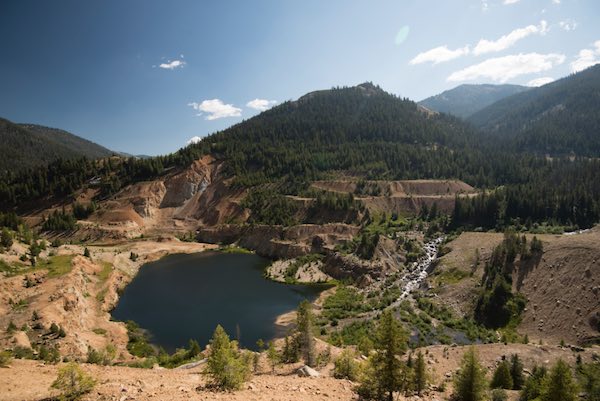forum
library
tutorial
contact

Nez Perce Tribe Files Suit Against
Midas Gold Over Plans for Mine
by Eric Barker
Lewiston Tribune, August 10, 2019
|
the film forum library tutorial contact |

|
Nez Perce Tribe Files Suit Against
by Eric Barker
|
The release of arsenic, cyanide, mercury and other heavy metals are the result of nearly a century of mining,
and were happening long before Midas Gold Corporation acquired the site about 10 years ago.
 The Nez Perce Tribe filed a Clean Water Act lawsuit Friday against a company seeking to restart an idled open-pit mine in a remote area of central Idaho.
The Nez Perce Tribe filed a Clean Water Act lawsuit Friday against a company seeking to restart an idled open-pit mine in a remote area of central Idaho.
In the complaint filed in U.S. District Court at Boise, the tribe claims the company is discharging pollutants into tributaries of the South Fork of the Salmon River without a permit from the Environmental Protection Agency and not taking action to halt release of the pollutants. The tribe had previously filed a notice of intent to sue the Canada-based Midas Gold Corp. and its Idaho-based subsidiary, Midas Gold Idaho.
The tributaries include the East Fork of the South Fork Salmon River, Meadow Creek and Sugar Creek, which are home to spring and summer chinook salmon, steelhead and bull trout, all of which are protected by the Endangered Species Act. The tribe has reserved rights, enumerated in its 1855 Treaty, to harvest fish within its historic territory, which includes the site east of McCall and near the tiny community of Yellow Pine. It also spends about $2.8 million per year in fish restoration activities in the South Fork of the Salmon River drainage, and its members continue to fish there.
"The reality is that Midas Gold has worked on and studied the project site since 2009, but has not taken action to address the existing sources of pollution at the proposed project site that are entering and harming the East Fork South Fork Salmon River and the fish, wildlife, and people who rely on it," said Shannon Wheeler, chairman of the Nez Perce Tribal Executive Committee. "The Tribe has dedicated substantial resources to learning about the project and the work being done by Midas Gold. The tribe has determined that these ongoing illegal discharges are harming the tribe's culturally significant, treaty-reserved resources, including its fisheries."
The tribe is on record as opposing the company's proposal to reopen the mine.
Midas Gold, which acknowledges discharges of pollution are coming from its Stibnite property and has documented them to state and federal regulators, issued a statement Friday saying the release of arsenic, cyanide, mercury and other heavy metals are the result of nearly a century of mining, and were happening long before it acquired the site about 10 years ago.
The company has not mined at the site, but has developed a proposal to mine old tailings and pits at the property, and use formerly undisturbed areas to store tailings while also working to clean up pollution left by former owners of the property. The company also said it plans to fix fish passage problems that prevent chinook from reaching spawning areas above one of the open pits at the mine.
Midas Gold Idaho CEO Laurel Sayer called the tribe's lawsuit unfortunate and said it is delaying work to mitigate the pollution there.
"Midas Gold and the tribe are aligned on our concerns over water quality in the historic mining district and believe something must be done," she said. "This is why we've been working with the federal and state environmental regulators for well over a year and a half on solutions, and for much longer on permitting the permanent solution. And, while we agree the site needs immediate attention to clean up the damage of the past, make no mistake -- the problems outlined in this lawsuit were not caused by Midas Gold.
"We agree there is a problem, but a far better path would be for the tribe to spend its energy and resources working with us on a solution rather than filing lawsuits. Filing a lawsuit at this stage merely impedes the process of the site getting the attention it deserves."
The company contends it is not liable for the pollution left by previous owners, according to the Comprehensive Environmental Response, Compensation and Liability Act. Nonetheless, it said its plan to develop a mine on the site will fund pollution mitigation there.
The tribe contends that over the 10 years the company has owned the site, it has not acquired National Pollutant Discharge Elimination System permits authorizing the release of pollution into the creeks and river. The tribe's lawsuit does not mention the company's stated intention of addressing much of the pollution at the mine as part of its work to open and operate the mine.
Midas Gold is proposing to conduct mining operations in two existing open pits at Stibnite, to reprocess existing, unsecured mine tailings stored at the site and to develop a third open pit at an area that is already disturbed and polluted. The company plans on securely storing tailings in an area that has not been disturbed.
Midas Gold submitted a Plan of Restoration and Operation to the U.S. Forest Service, which is under review by the agency. It is working with both the EPA and Idaho Department of Environmental Quality to study sources of the pollution and come up with solutions, said Midas Gold spokeswoman Mckinsey Lyon.
"We can't touch anything on the site without regulatory approval," she said.
Related Pages:
Gold Mine Plan in Central Idaho Wilderness Draws Objections by Keith Ridler, Washington Times, 3/22/15
Report States Need to Protect Rivers, by Staff, Idaho Mountain Express, 3/4/15
learn more on topics covered in the film
see the video
read the script
learn the songs
discussion forum
